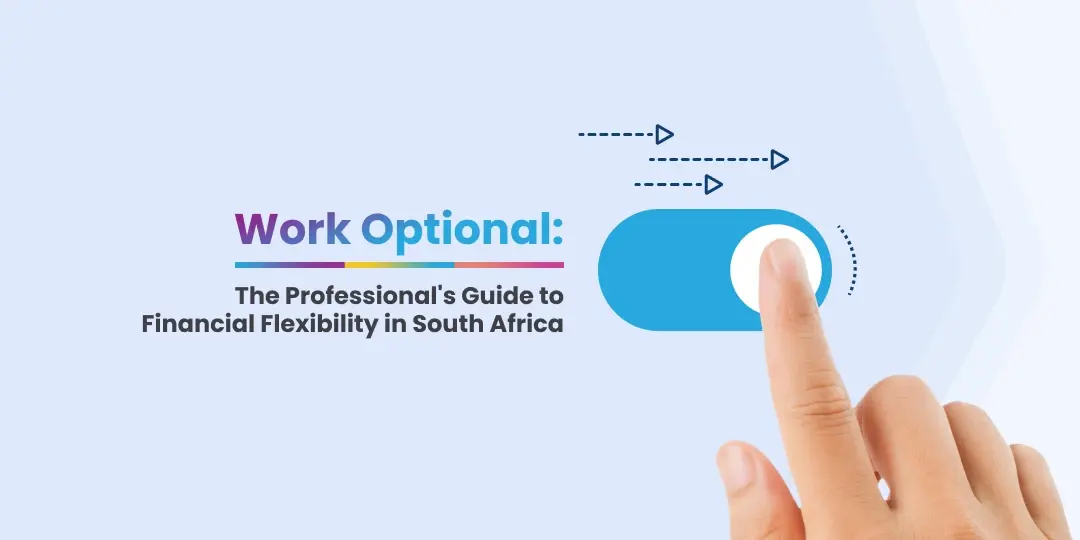Work Optional: What It Really Costs to Achieve Financial Flexibility
22 August 2025

You've read the FIRE (Financial Independence Retire Early) blogs. You know about the 4% rule and compound interest. But the FIRE movement, popular in the US, often talks about retiring at 35, surviving on $40,000 a year, and obsessing over 401(k) strategies.
That's not what most of us want. We want flexibility, not frugality. Options, not optimisation to the last cent. The ability to take risks, pivot careers, or tell that toxic boss goodbye - without checking our bank balance first.
Welcome to Work Optional: the achievable middle ground between wage slavery and extreme early retirement.
Work Optional: The Sweet Spot of Financial Freedom
Work Optional means having enough invested to cover 60-70% of your expenses indefinitely. You're not fully financially independent, but you have massive flexibility.
Take that two-year sabbatical to write a book. Start the business without a safety net. Move to part-time consulting. Take the meaningful job that pays half your current salary. Your investments cover most of your life; work fills the gap on your terms.
The math is simpler and more easily achievable than full retirement, and the timeline is years shorter.
The Numbers: What Work Optional Actually Requires
Work Optional doesn’t mean covering your entire lifestyle with investments. It means your portfolio safely covers about 60% of your expenses, and you use flexible work or side income for the rest. That requires approximately 40% less capital than full financial independence, saving you years on your timeline.
Let's assume 5% real returns (after inflation, fees, and taxes) and a 4% withdrawal rate:
For Work Optional (covering 60% of expenses):
- R30,000/month lifestyle → R5.4 million invested
- R50,000/month lifestyle → R9 million invested
- R80,000/month lifestyle → R14.4 million invested
| Lifestyle (per month) | Work Optional Pot | Safe Monthly Income from Pot (4%) | What You Still Need from Work |
|---|---|---|---|
R30,000 | R5.4 million | R18,000 | R12,000 |
R50,000 | R9 million | R30,000 | R20,000 |
R80,000 | R14.4 million | R48,000 | R32,000 |
For comparison, full financial independence requires:
- R30,000/month lifestyle → R9 million invested
- R50,000/month lifestyle → R15 million invested
- R80,000/month lifestyle → R24 million invested
Work Optional requires 40% less capital than full FI. That's years of difference.
| Lifestyle (per month) | Work Optional (60% covered) | Full FI (100% covered) | Time Saved |
|---|---|---|---|
R30,000 | R5.4 million | R9 million | ~4–5 years |
R50,000 | R9 million | R15 million | ~6–7 years |
R80,000 | R14.4 million | R24 million | ~8–10 years |
The Savings Rate: Your Only Real Lever
Here's the truth: your savings rate determines your timeline more than any other factor. Assuming 5% real returns consistently:
Time to Work Optional (60% of expenses covered):
- Save 20% → 19 years
- Save 30% → 14 years
- Save 40% → 11 years
- Save 50% → 8.5 years
- Save 60% → 6.5 years
Double your savings rate, halve your timeline. It's that brutal and that simple.
The Real Return Reality Check
That 12% return your fund advertises needs adjustment:
12% nominal return
- 5% inflation = 7% real
- 1.5% fees = 5.5% real
- 0.5-1% tax drag = 4.5-5% real
This 5% real return is what actually matters for your projections. Every calculation should use this number, not the marketing materials.
The industry average fee of 2.5% instead of 1%? That drops your real returns to 3.5-4%. Over 20 years, that seemingly small difference devastates your timeline to Work Optional.
Three Core Habits Before Any Optimisation
People achieving Work Optional share three habits that matter more than perfect asset allocation:
- They track expenses obsessively for three months, then periodically. Not forever, just long enough to understand where money actually goes versus where they think it goes. Use apps like 22seven, FNB nav>> Money, or your bank’s built-in tools - or simply export your bank statement monthly, highlight unnecessary spends, cut them next month, and redirect that money into investments.
- They automate savings immediately after payday. What you don't see, you don't spend. They start at 20%, increase quarterly until uncomfortable, then back off slightly. This becomes their permanent savings rate.
- They ignore lifestyle inflation completely. Every raise, bonus, and tax refund goes to investments. They live on last year's salary while earning this year's. This habit alone can cut the timeline to Work Optional by 40%.
The Tax-Efficient Path to Work Optional
Year 1-5: Maximum Tax Efficiency
TFSA first, always. R36,000 annually, R3,000 monthly debit order. No tax on growth or withdrawal ever. This is your first R500,000 of Work Optional money.
RA up to meaningful tax benefit. At 41% marginal rate, contributing R10,000 monthly costs you R5,900 after tax refund. That's a 69% instant return. The new savings pot feature (one-third accessible before 55) makes RAs surprisingly flexible for Work Optional planning.
Debt versus investing math. [Assumption] Bond at 11%? That's a guaranteed after-tax "return" by paying it off. Your RA might average 12% nominal (7% real), but with uncertainty. Many pursuing Work Optional split the difference: minimum bond payment plus extra to RA for the tax benefit.
Year 5+: Scaling Up
Discretionary investments for flexibility. Once tax-advantaged vehicles are maxed, unit trusts or ETFs provide access before 55. Yes, you'll pay capital gains tax (effective rate 18% for high earners), but flexibility has value for Work Optional.
Offshore considerations. The R1 million single discretionary allowance needs no tax clearance - use this first if going direct offshore. For most pursuing Work Optional, 30-40% offshore exposure through local funds is simpler than managing foreign accounts and situs tax.
What Work Optional People Actually Do (Not Advice)
Observing those who've achieved Work Optional locally, patterns emerge:
They tend to front-load tax-advantaged accounts (TFSA and RA) in their 30s, accepting the access restrictions for the tax benefits.
Around age 40, they shift focus to discretionary investments for flexibility, having built a solid tax-protected base.
They rarely optimize for the last percentage point of returns. Instead, they focus on consistency: same amount, same day, every month, for years.
Most keep their bonds despite the math sometimes favoring investing. The psychological benefit of a paid-off home seems to outweigh the mathematical optimization.
The Sequence of Returns: Less Critical for Work Optional
Full retirees obsess about sequence of returns risk - a market crash early in retirement can be devastating when you're 100% dependent on investments.
Work Optional? Less critical. You're still earning something. A 30% market crash when you're Work Optional means you work full-time for a year or two while markets recover. Annoying, not catastrophic.
This resilience means you can maintain a higher equity allocation longer, potentially accelerating your timeline.
Why "Enough" Is Harder Than the Math
The target keeps moving. You aim for R5 million Work Optional, reach R4 million, and suddenly R7 million feels safer. This is universal and expected.
Define Work Optional concretely:
- Core expenses you want covered by investments: R______/month
- Minimum work income you're comfortable earning: R______/month
- Total lifestyle you're targeting: R______/month
When investments can sustainably generate the first number, you're Work Optional. The gap between core expenses and total lifestyle? That's your flexibility zone.
The Uncomfortable Truth About Fees
A 1.5% fee difference might seem trivial. It's not.
On R30,000 monthly contributions over 15 years:
- At 1% fees: R12.3 million
- At 2.5% fees: R10.1 million
That R2.2 million difference? That's two years of Work Optional life at R90,000/month.
This isn't about finding the absolute cheapest option. It's about understanding that every 0.5% in fees delays Work Optional by roughly one year.
Compare your retirement investments
Effective annual cost calculator10X in the Work Optional Journey
The 10X Your Future Fund targets inflation plus 5.5% at 1% annual fees. No performance fees, no surprises. Strategic asset allocation without market timing.
For those wanting pure offshore exposure, the MSCI World Feeder Fund provides it, handling the tax complexity.
The math of low fees isn't marketing - it's the difference between Work Optional at 45 versus 50.
Three Actions for This Week
Calculate your actual savings rate. Last month's savings divided by after-tax income. Below 30%? Work Optional is more than 15 years away.
Total your investment costs. Every fee, every layer. If it's above 1.5%, you're adding years to your timeline unnecessarily.
Define your Work Optional number. Core expenses × 12 ÷ 0.04 × 0.6. That's your target. Divide by your current savings rate to get your timeline.
The Choice Is Binary
You'll either reach Work Optional in your 40s or 50s, or you'll work until traditional retirement. There's rarely a middle ground - compound interest doesn't allow for it.
The difference isn't intelligence, income, or investment sophistication. It's whether you save 30-50% of income versus 5-10%.
Everything else - asset allocation, tax optimization, fee minimization - just accelerates or delays the inevitable outcome your savings rate determines.
Your 45-year-old self will either have options or obligations. The math is indifferent to your choice.
Calculate your Work Optional timeline with our retirement calculator or speak to a 10X consultant about structuring for flexibility, not just retirement.
Related articles
How can we 10X Your Future?
Begin your journey to a secure future with 10X Investments. Explore our range of retirement products designed to help you grow your wealth and achieve financial success.


